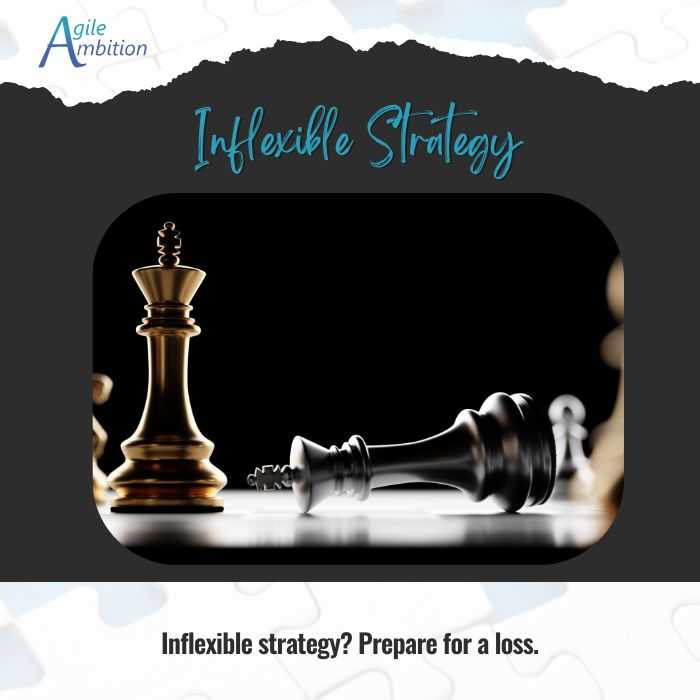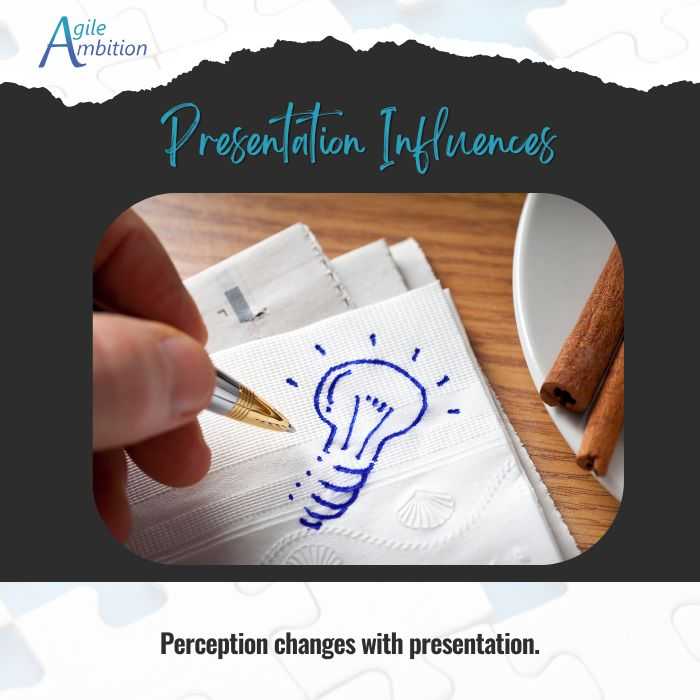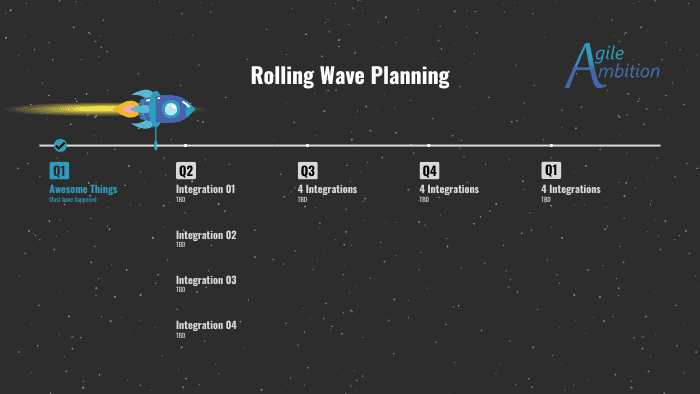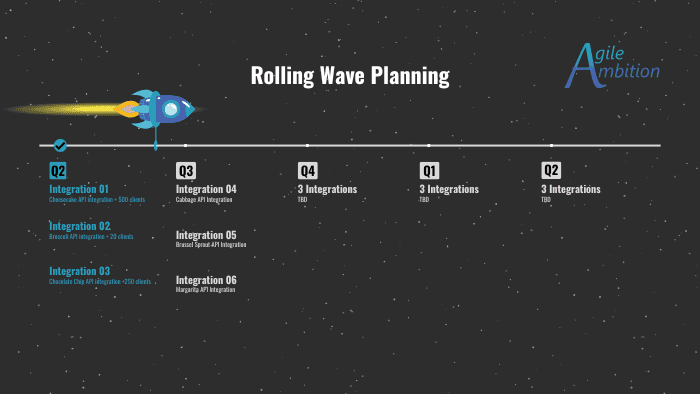Rolling Wave Planning: Embracing Uncertainty

You can’t stop the waves from coming, but you can choose whether to ride them or drown. Rolling wave planning is your life jacket in the sea of uncertainty.
What Is Rolling Wave Planning?
Rolling wave planning is an iterative technique that details near-term tasks while leaving future tasks flexible, refining them as they approach execution. Leaving future tasks flexible may seem inefficient, but it enables adaptive planning.
In rolling wave planning, you set a horizon—whether three months or a year—and break it into meaningful chunks. These chunks will be larger than your typical Sprint length, preventing the tedium of preplanning Sprints.
They’re called waves—these chunks of time we carve out. They’re a way to see the work’s rhythm and how progress flows like the tide. One wave builds, crashes, and fades, but another is already forming behind it before the first is gone. It is not unlike the heartbeat of a Sprint, but with a gentler ebb and flow, allowing space for discovery.
Your first wave—the one you’re riding right now—might be 80 to 90 percent planned. But even then, there’s room for the unexpected. Work shifts and reveals itself in ways you didn’t see coming, even within the small window of a single Sprint.
The second wave, the one just beyond, might only be 40 to 60 percent clear. The further out you look, the murkier it gets. You can’t perfectly map the future; you must figure it out as you go, one wave at a time.

If progressive elaboration rings a bell, this should feel like familiar ground.
Rolling Wave Planning vs Progressive Elaboration
Progressive elaboration is the process of adding detail over time as we learn more. Rolling wave planning is a technique that applies progressive elaboration in waves. Managing transitions between these waves is vital to success.
If you don’t carve out time to plan, it’s easy to find yourself drowning. One minute, everything’s under control; the next, you’re buried under a mountain of work you didn’t see coming. Planning in waves can intensify the problem. If you aren’t setting aside time to prepare for the next round of tasks—the ones just over the horizon—you’ll soon be scrambling to break down features. That’s a surefire way to invite burnout and inefficiency. As you work through the first wave, it’s crucial to block time to prepare for what’s next because the second wave is always closer than it seems.
At first glance, Sprint Planning might seem like a form of rolling wave planning. After all, both follow a regular rhythm. But dig a little deeper, and you’ll see they’re not quite the same thing. There’s more to it than just cadence.
What Is the Difference Between Rolling Wave Planning and Sprint Planning?
The difference between rolling wave and sprint planning is duration: sprint planning covers the next Sprint (typically two weeks) while rolling wave planning spans broader, long-term waves. Rolling wave planning also communicates a level of uncertainty that sprint planning’s fixed intervals can’t achieve.
Rolling wave planning is like the bridge you didn’t know you needed—filling the gap between sprint-level focus and the bigger picture your business demands. When you’re only planning Sprint by Sprint, you’re stuck reacting, responding to what’s right in front of you, and sometimes that’s not enough.
During Sprint Planning, you define a Sprint Goal, knowing it’s just one step toward the bigger Product Goal. That Product Goal sits at a strategic level, something that unfolds over the course of many Sprints. But connecting that high-level vision to the day-to-day reality of each Sprint isn’t always easy. That’s where rolling wave planning comes in. It keeps you from seeing each Sprint as a separate piece, reminding you that every step is part of a broader journey that ensures you’re constantly moving with purpose toward your ultimate goal.
You might think preplanning next year’s Sprints would achieve the same result. But there are consequences to that approach, ones that rolling wave planning helps you avoid.
What Are the Benefits of Rolling Wave Planning?
Rolling wave planning enhances flexibility, minimizes wasted effort, and increases transparency by focusing on near-term tasks while keeping future plans adaptable. While many expect flexible plans to be inefficient, rolling wave planning proves otherwise by reducing wasted effort and adapting to new information.
Humans have this way of clinging to plans, no matter how outdated or irrelevant they’ve become. Something about putting a plan in place makes us stubbornly hold on, even when it’s clear we need to change course. We go so far as to create metrics—like the say-do ratio—that measure how well we stick to those plans. And then, there are baselines. We compare where we are to where we expected to be, constantly forcing reality to align with a plan that may no longer make sense.

Sticking too rigidly to a plan can choke off adaptability and stifle creativity. But we’ve been doing it this way for so long that it’s become second nature—something we almost can’t shake, even when it’s holding us back. The trick to avoiding that straight-jacketed feeling? Stop over-planning. Keep things flexible, and leave some room for change.
Think of rolling wave planning as just-in-time planning. The details don’t fall into place until they’re needed, as the work gets closer. We purposely leave the far-off tasks less defined because everything might have changed anyway by the time we get there. We keep our options open by holding back on planning too far ahead and staying flexible enough to adjust when needed. It’s how we avoid getting stuck in a plan that no longer fits, and it saves us from wasting time reworking everything when new information inevitably rolls in.
Lastly, rolling wave planning can bring more transparency and help stakeholders get comfortable with uncertainty. When we preplan at the Sprint level, even though those future Sprints are just placeholders until Sprint Planning, something about seeing work attached to specific dates gives it the feel of a promise. To a stakeholder, it looks like a guarantee, even when it’s not, simply because it’s written down with a timeline attached.

In rolling wave planning, we make it clear—through visuals or conversations—that the waves further out on the horizon aren’t set in stone. They’re tentative, based on what we know right now, and they’ll likely shift as we move forward. Referring to future features and epics as “suppositions” or “contenders” helps drive home the idea that nothing’s guaranteed and everything’s still negotiable.
We’ve talked about how rolling wave planning embraces uncertainty. But what does this look like in action?
Rolling Wave Planning Example
An example of rolling wave planning in project management is organizing a project quarter by quarter, detailing the first quarter, and refining the rest over time. Unlike traditional plans, which start fully detailed, rolling wave planning adapts wave by wave, focusing on immediate tasks.
Imagine your current hypothesis is that integrating with 16 new third-party vendors this year will help you achieve your product goal of onboarding 4,000 new clients. Since these integrations are new, you don’t have prior experience or historical data to determine whether this goal is realistic.
At first glance, you might set your horizon at one year since that’s the natural timeframe you’re considering to achieve this Product Goal.
Assuming your Sprints are two weeks long (a typical length), you could try to preplan all 26 Sprints for the year. But as we’ve discussed, this leads to wasted effort. With so much ambiguity—since you haven’t done the first integration yet—preplanning 26 Sprints would be nearly impossible at best and wildly inaccurate at worst. You need a less rigid chunk of time to plan.
I like working in quarters. Something about 13 weeks feels right—long enough to make real progress but short enough to give you time to course-correct if needed. It’s a natural rhythm and the best part? Most businesses already think in quarters. You’re meeting them where they are, tapping into a cycle they’re comfortable with, which makes everything run a little smoother.
You’re going to break your year into four quarterly waves. For each one, you’ll start thinking about what work to target. Right now, you’re working with a lot of assumptions—it’s just part of the process until you have more solid information to adjust the plan. You know there are 16 integrations to tackle across four quarters, so you’ll start by aiming for four integrations per quarter. It’s a rough estimate but gives you a place to start.
You don’t want to clutter things with too many pieces to manage—whether it’s records in an Excel sheet, issues in Jira, or boxes scattered across a roadmap. You don’t have enough information to plan at that level of detail. So, for each quarter, let’s keep it simple: one box labeled “4 Integrations.” That’s all you need for now; it’s just a rough guide until things get clearer.
Even though this is an annual plan, you might start in March, so Q2 becomes your first quarter, and everything shifts from there. But here’s what I want to emphasize: this is a rolling wave annual plan. As soon as you finish one quarter, it drops off the front of the timeline, and you add a new one to the back. This plan isn’t your typical January-to-December kind of planning. You’re working with a rolling time window, adjusting based on what makes sense for you. And for some, that one-year window might not be the best fit—it’s all about finding what works for your context.
Since Q2 is your starting point, it’s time to dig deeper. You’ll want to begin planning it with more detail. You might at least set a placeholder for each integration you’ll tackle this quarter. It doesn’t have to be perfect, just enough to get the ball rolling.

In Q2, you’ll keep breaking down those epic or feature-level targets into user stories, planning them during your usual Sprint Planning sessions. And as always, you’ll learn more along the way. I know this example is a bit far-fetched but stick with me. Let’s say you integrate with a cheesecake API first, which nets you 500 new clients. Not bad, right? If every integration brings in 500 clients, you will hit your goal of 4,000 new subscribers well before completing all 16 integrations.
But then comes the second integration, this time with a broccoli API, which doesn’t have the same effect—just 20 new clients. It was hardly worth the effort. Noticing a pattern, you start to sense that sugar-related APIs might bring in more clients. So, for the third integration, you aim for the chocolate chip API.
By this point, or maybe even a little earlier, you realize that aiming for four integrations per quarter isn’t realistic. Three feels more manageable, a pace you can sustain without burning out. It’s a goal that makes sense.
At the end of Q2, your rolling wave plan might look something like this:

You’re sitting at 770 total clients, aiming for that 4,000 mark by the end of Q1. You’ve got a sense of which integrations to focus on next, and you’ve already adjusted your expectations for the quarters ahead, knowing that three integrations per quarter is more realistic. But here’s the catch: leadership is pushing for healthier integrations. Even though the sugar-related ones are getting results, you’re being steered toward cabbage and brussel sprout integrations. They’re convinced that the proper healthy option hasn’t yet clicked with your market.

Q3 plays out much like Q2—you completed three more integrations. But this quarter is packed with lessons. After two underwhelming integrations, you switch to another sugar-laden one, and it’s a game-changer. The Margarita API alone brings in enough clients to hit your goal of 4,000 new subscribers. Sometimes, the sweet stuff just works.
Now that we’ve hit our Product Goal, it’s time to consider what’s next. We didn’t expect to get here so soon, so the next goal isn’t fully fleshed out yet. But here’s what we know: with all these new clients, the system’s slowing down, and a few customers are already voicing their frustration. So, maybe the new goal shifts toward customer retention—keeping what we’ve gained before it slips away.
Q1 is still a little ways off, but you’re already hearing rumblings from the accounting and billing teams. Their systems could use some love to keep up with the influx of new clients. It’s probably wise to tackle that before jumping into any new integrations. When you shift focus back to growing the client base, someone floated the idea of a guacamole integration. It pairs nicely with the margarita crowd and has a healthier spin, which might satisfy leadership.
If you had stuck rigidly to your original plan without adjusting based on outcomes and learnings, integrations 7 through 16—more than three quarters of work—would have been wasted effort. You might argue that as long as they brought in any clients, it wasn’t a total waste, but that time and energy would have pulled you away from more worthwhile goals for your company. Worse, if you ignored the early signs that your clients preferred sugar over veggies, you could have slogged through all 16 integrations without meeting your product goal.

Or maybe you would’ve reached your client count goal, but because you had 16 integrations mapped out, you kept pushing ahead, unwilling to shift course. And with each passing quarter, the system slowed down more and more—until most of your clients eventually canceled.
TLDR
Waves of uncertainty will always roll in, but with rolling wave planning, you can ride them instead of being dragged under. Stay flexible, adjust as you go, and avoid drowning in rigid plans.
- Rolling wave planning helps you manage uncertainty by detailing near-term tasks while leaving future tasks flexible and adaptable.
- It bridges the big-picture Product Goal and the more tactical Sprint planning.
- Breaking work into manageable waves prevents over-planning and allows for natural adjustments as priorities shift.
- Flexibility isn’t inefficiency. Rolling wave planning minimizes wasted effort by refining plans when it makes the most sense.
- Planning too far ahead leads to outdated strategies and wasted effort. Rolling wave planning keeps you focused on what’s relevant now.
- Using progressive elaboration, rolling wave planning applies just-in-time detailing, allowing you to add clarity as work moves closer.
- Rolling wave planning brings transparency to stakeholders, helping them understand that future work is tentative and adaptable as more data becomes available.
- Most importantly, rolling wave planning prevents you from getting stuck in a plan that no longer fits.
Works Consulted
- Scrum Guide
- Agile Manifesto
- Why Some Teams Almost Always Fail at Preplanning Sprints
- Avoiding the Rapids: Plan Proactively
- Understanding Product Goals by talking about Epics
- Alternatives for Agile and Lean Roadmapping: Part 2, Rolling Wave Planning Inside One Quarter
Share
Table Of Contents
Fuel an Idea
Every week, I break down complex ideas, strip away the fluff, and give you experiments to turn knowledge into skills.
If that’s worth a coffee, consider fueling the next big insight.
No pressure. No guilt trips. Just impact.
Buy Me a CoffeeRelated Posts
Quick Links
Legal Stuff

